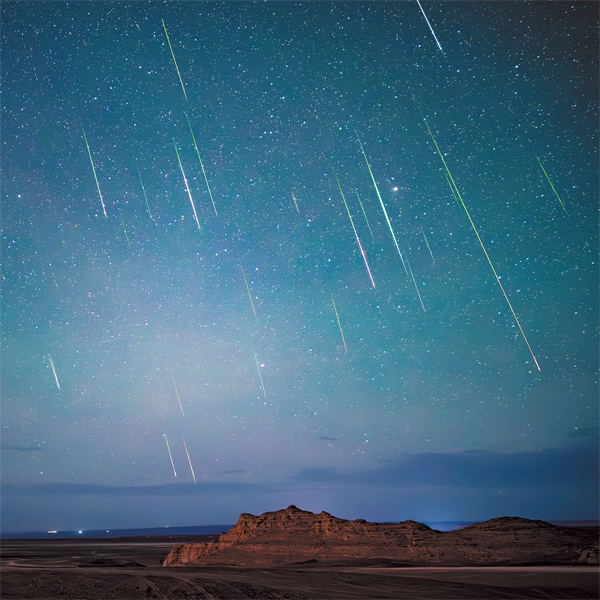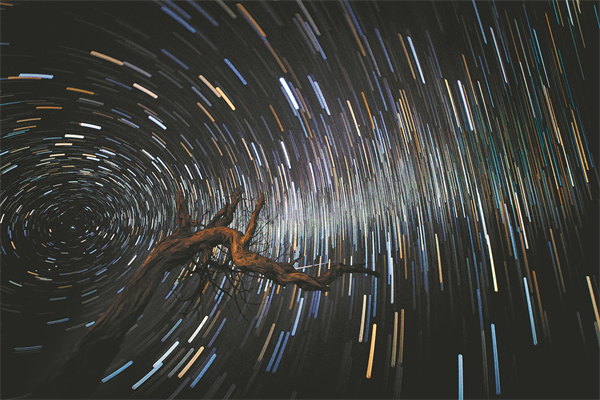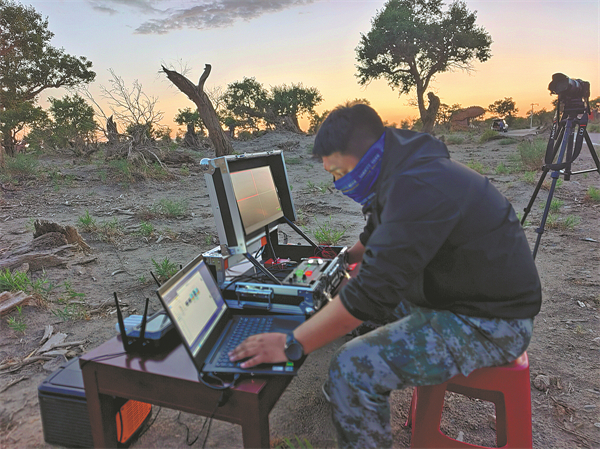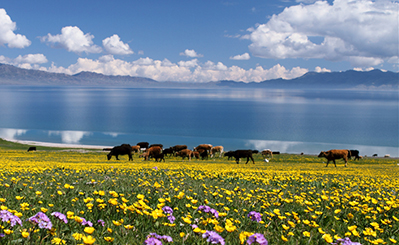Stargazers add luster to little-known prefecture

The Perseids meteors travel across the night sky at the Dahaidao scenic area in Hami prefecture, Xinjiang Uygur autonomous region, on Aug 12. [Photo/Huang Dandan]
Annual festival draws astronomy enthusiasts and introduces Hami, Xinjiang, to tourists
As the Perseids meteor shower peaked during the second weekend of this month, it ignited people's passion for stargazing and became a hot topic on Chinese social media.
Behind the online fervor was the government of a lesser-known prefecture in the Xinjiang Uygur autonomous region and a group of obsessed astronomy photographers.
The former, the government of Hami prefecture, expected to increase Hami's reputation as a travel destination by organizing a stargazing event. The latter, members of the China StarVision Alliance, a platform for nearly 1,000 Chinese astronomy photographers and businesses related to dark sky tourism, hoped to promote stargazing and dark sky tourism among the public.
Together, they have organized an annual festival, titled "Sweet Whispers to the Galaxy", since last year.
The festival has two sessions every year, said Liu Xuehua, an official of the Publicity Department of the Hami Prefecture Committee of the Communist Party of China, "hopefully to coincide with some major astronomical phenomena".
The second session of this year's event was held between Aug 10 and 15, coinciding with the peak of the meteor shower.

Star tracks in the sky in Yiwu on Aug 14. [Photo/An Jiu]
Why stargazing?
According to Liu, even though Hami has an area of more than 137,000 square kilometers — slightly smaller than Shandong province — boasts diverse landscapes, including snow-capped mountains, deserts and grasslands, and has rich tourism resources, the prefecture is still not widely known as a tourist destination. In Xinjiang, Urumqi city and Altay and Ili prefectures are more popular among travelers.
Since 2017, she said, the local government has considered using dark sky tourism as a way to increase the prefecture's popularity and improve its reputation as a travel destination.
In 2020, it invited a group of astronomy photographers to visit the area and take photos at its various landmarks. Of them included Wang Junfeng, an experienced astronomy photographer, online influencer and one of the co-founders of CSVA.
He was impressed by Hami's condition as a dark sky travel destination.
"Hami has vast wild areas without any light pollution and spectacular and diverse backdrops for star photography," Wang said. "It can be a magnet for our photographers and stargazing enthusiasts."
Also working with China Image Group in Beijing as a project manager, he succeeded in helping the Hami government, China Image Group and CSVA jointly launch the festival in June last year and its second session around the New Year holiday.
Because of the travel inconveniences caused by the COVID-19 epidemic, few astronomy photographers living outside of Xinjiang were invited to participate in the first session, Wang said.
"So we decided to use livestreaming to promote the event," Wang said. "The result was way beyond our expectations."
The festival has garnered 120 million hits on various online platforms, Liu said. As a result, it has become a primarily online livestreaming event. "We realize that it's truly an efficient way to help promote Hami," Wang said.

An engineer tests equipment before a livestreaming session of the meteor shower at the Poplar Forest Scenic Area in Yiwu county on Aug 14.
Livestreaming meteors
On the evening of Aug 10, Liu, several members of the local government's logistics team and a few reporters from a local media center arrived at a meadow at an altitude of 2,600 meters above sea level. It is encircled by mountaintops and overlooks a river in the Tianshan Mountains.
They started pitching tents and made a fire to cook food and brew milk tea. At 10:30 pm, some other participants — Zhou Bo, an astronomy photographer and another co-founder of CSVA, and three CSVA engineers — finally arrived at the campsite. The four, who spent more than a day driving from Beijing to the site, were tasked with livestreaming the event online.
Wang left Beijing early that morning and reached the site after taking a flight and then a train. Two other photographers drove up from Yinchuan, Ningxia Hui autonomous region.
After dinner, the photographers, wearing down jackets, spread out around the site and started taking photos. The sky was clear, and the Milk Way looked close. The Perseids shooting across the dark sky caused cries of amazement from time to time.
A shooting star was seen every 15 to 20 minutes, Wang observed.
"It means that the meteor shower is active and peaking," he said.
On the morning of Aug 11, the whole group of less than 30 people returned to Hami city. They hung out there before heading to Dahaidao, a scenic area hidden in the middle of the Gobi Desert about an hour's drive from the town, in the evening.
"In the daytime, the desert is too hot and dangerous to stay," Liu explained.
Meanwhile, photos and video clips of the meteor shower taken by the photographers in the wee hours of the morning were published by local media outlets and began to appear on Chinese social media platforms.
After the last photographer, An Jiu, joined the group, they headed to Dahaidao and arrived at a campsite with a backdrop of a massive Yadan landform, or a barren area with wind-eroded landscape, at 9 pm. Because of the region's geographical location, the sun had just set.
While members of the logistics team made dinner at the site, Zhou and his livestreaming team went to the foot of a sheer cliff and prepared to livestream the meteor shower.
"We have to start livestreaming as soon as possible," Zhou said. "Otherwise, it will be too late for our viewers living in other parts of the country to hang on with us."
Skipping dinner, Zhou and his team held a two-hour livestream, and Wang shared the link on the websites of a couple of national media outlets. Millions of viewers tuned in to the live broadcast, Zhou estimated later.
On Aug 12, the group left Dahaidao in the morning and arrived in Barkol Kazak autonomous county.
From about 3 pm to midnight, Zhou and Wang took turns livestreaming the shooting star display on the bank of a wetland.
"It's hard work," Zhou said. "But I can cooperate with Junsong, or let An Jiu be my guest host. Believe it or not, I once livestreamed alone for 11 hours."
In that evening, the Perseids shower was a hot topic on Chinese social media.
After the live broadcast, some photographers continued to work into the wee hours of the morning, but were interrupted by a thunderstorm.
It rained on the morning of Aug 13 and was cloudy in the afternoon and evening. Zhou left his team to go to Qinghai province for a meeting on tourism development. Wang decided to livestream the meteor shower in the courtyard of the hotel they were staying at.
"We originally planned to work in a temple on the Tianshan Mountains," Wang said. "But it would have been too cold and pointless without a clear sky."
Fortunately, several CSVA photographers joined Wang's livestream and discussed their sightings from other parts of the country.
"Our platform is a gathering of photographers from across the country," Wang said.
"So even though viewers of our live broadcast can't see shooting stars from here, they can view them from other places."
Happy ending
The next day, the group moved to a scenic area featuring a poplar forest in a desert in Yiwu county. Ancient trees in various shapes provided unique backdrops for astronomy photos.
Between 10 pm and midnight, dozens of meteors shot across the clear, dark sky. Wang ended the fourth and final livestream and quietly admired the spectacle with other festival participants.
According to Liu, the Hami official, the five-day event resulted in 60 million hits on various social media platforms.
The first session in January garnered 80 million online hits.
Overall, Liu was pleased with the outcome. "The second session's number (of online hits) is lower," Liu said. "But it's mainly because more institutions joined to livestream the meteor shower and the online volume has been split. To be honest, we are still satisfied by what we achieved."
In the Dahaidao scenic area, the group had to share the campsite with dozens of other tourists who drove cars to the site.
"That means more people considered Hami to be a destination for stargazing," the official said.
 Attractions
Attractions Dining
Dining Culture
Culture